#I get that costume departments like to stretch their creativity but not making an effort with continuity just feels like they don't like
Text
I'm trying to make my way through Star Trek chronologically, some series I've not seen before, some I'm rewatching. (I'm realizing this might not be possible to do evenly so I'll just go by the start of each series.)
But I am very much NOT emotionally stable enough to handle a "torturing a tardigrade" plot line so I may have to put a pause on Discovery for a minute.
#I'm also very annoyed by the Klingons#I get that costume departments like to stretch their creativity but not making an effort with continuity just feels like they don't like#the source material#if you don't like it then make something original?#I know not that simple but ugh the klingons have been redesigned so much it's just really fighting with the other series and#it makes it less enjoyable
0 notes
Text
Watchmen - Movie blog
(SPOILER WARNING: The following is an in-depth critical analysis. if you haven’t seen this movie yet, you may want to before reading this review)
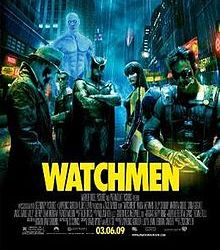
A movie adaptation of Watchmen had been in development in some form or another since the graphic novel was first published back in 1987. Over the course of its two decade development cycle, being passed from filmmaker to filmmaker who each had their own vision of what a Watchmen movie should be, fans objected to the idea of a movie adaptation, describing Watchmen as ‘unfilmmable.’ Alan Moore himself condemned the effort to adapt his work, saying that Watchmen does things that can only be done in a comic book. But where there’s a will, there’s a way, and in 2009, Watchmen finally came to the big screen, directed by Zack Snyder.
I confess it took me a lot longer to write this review than I intended and that’s largely because I wasn’t sure how best to approach it. Snyder clearly has a lot of love and respect for the source material and tried his best to honour it as best he could. Snyder himself even said that he considers the film to be an advert for the book, hoping to get newcomers interested in the material. So how should I be looking at this film? As an adaptation or as an artistic tribute? More to the point, which of the three versions of the film should I be reviewing? The original theatrical cut, the director’s cut or the ultimate cut? Which best reflects Snyder’s artistic vision?
After much pondering, I decided to go with the director’s cut. The theatrical release was clearly done to make studio execs happy by keeping the runtime under three hours, but it comes at the cost of major plot points and character moments being chucked away. The ultimate cut however comes in at a whopping four hours and is arguably the most accurate to the source material as it also contains the animated Tales Of The Black Freighter scenes. However these scenes break the narrative flow of the film and were clearly not intended to be part of the final product, being inserted only to appease the fans. The director’s cut feels most like Snyder’s vision, clocking in at three and half hours and following the graphic novel fairly closely whilst leaving room for artistic licence.
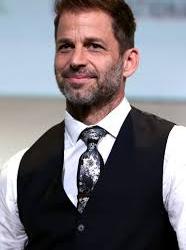
Now as some of you may know, while I’m not exactly what you would call a fan of Zack Snyder’s work, I do have something of a begrudging respect for him due to his willingness to take creative risks and attempt to tell more complex, thought provoking narratives that don’t necessarily adhere to the blockbuster formula. Films like Watchmen and Batman Vs Superman prove to me that the man clearly has a lot of good ideas and a drive to really make an audience think about what they’re watching and question certain things about the characters. The problem is that he never seems to know how best to convey those ideas on screen. In my review of Batman Vs Superman, I likened him to a fire hose. Extremely powerful, but unless you’ve got someone holding onto the thing with both hands and pointing it in the right direction, it’s just going to go all over the place. I admire Snyder’s dedication and thought process, but I think the fact that his most successful film, Man Of Steel, also happens to be the one he had the least creative influence on speaks volumes. When he’s got someone to work with and bounce ideas off of, he can be a creative force to be reckoned with. Left to his own devices however, and his films tend to go off the rails very quickly.
Watchmen is very much Snyder’s passion project. You can tell a lot of care and effort went into this. The accuracy of the costumes, staging and set designs speak for themselves. However there is an underlying problem with Snyder trying to painstakingly recreate the graphic novel on film. While I don’t agree with the purists who say that Watchmen is ‘unfilmmable’, I do agree with Alan Moore’s statement that there are certain aspects of the graphic novel that can only work in a graphic novel. A key example of this is its structure. Watchmen has the luxury of telling its non-linear narrative over twelve issues in creative and unorthodox ways. A structure that’s incredibly hard to translate into any other medium. A twelve episode TV mini-series might come close, but a movie, even a three hour movie, is going to struggle due to the sheer density of the material and the unconventional structure. Whereas the structure of the graphic novel allowed Alan Moore to dedicate whole chapters to the origin stories of Doctor Manhattan and Rorschach and filling in the gaps of this alternate history, the structure of a movie doesn’t really allow for that. And yet Snyder tries really hard to follow the structure of the book even though it simply doesn’t work on film, which results in the movie coming to a screeching halt as the numerous flashbacks and origin stories disrupt the flow of the narrative, causing it to stop and start constantly at random intervals, like someone kangarooing in a rundown car.
Just as Watchmen the graphic novel played around with the common tropes and framing devices of comics, Watchmen the movie needed to play around with the common tropes and framing devices of comic book movies. To Snyder’s credit, there are moments where he does do that. The most notable being the first five minutes where we see the entire history of the world of Watchmen during the opening credits while ‘The Times They Are A-Changing’ is played in the background. This is legitimately good. It depicts the rise and fall of the superhero in a way only a movie can. I wish Snyder did more stuff like this rather than restricting himself to just recreating panels from the graphic novel.
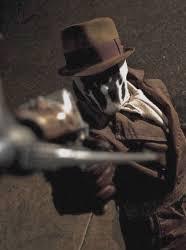
Which is not to say I think the film is bad. On the contrary, I think it’s pretty damn good. There’s a lot of things to like about this movie. The biggest, shiniest gold star has to go to Jackie Earle Haley as Rorschach. While the movie itself was divisive at the time, Haley’s portrayal of Rorschach was universally praised as he did an excellent job bringing this extreme right wing bigot to life. He has become to Rorschach what Ryan Reynolds is to Deadpool or what Mark Hamill is to the Joker. He is the character (rather tragically. LOL). To the point where it’s actually scary how similar Haley looks to Walter Kovacs from the graphic novel. The resemblance is uncanny.
Another standout performance is Jeffery Dean Morgan as the Comedian. Just as depraved and unsavoury as the comic version, but Morgan is also able to inject some real charm and pathos into the character. You believe that Sally Jupiter would have consensual sex with him despite everything he did to her before. But his best scene I think was his scene with Moloch (played by Matt Frewer) where the Comedian expresses regret for all the terrible things he did. It’s a genuinely emotional and impactful scene and Morgan manages to wring some sympathy out of the audience even though the character doesn’t really deserve it. But that’s what makes Rorschach and the Comedian such great characters. Yes they’re both depraved individuals, but they’re also fully realised and three dimensional. They feel like real people, which is what makes their actions and morals all the more shocking.
Then there’s Doctor Manhattan, who in my opinion stands as a unique technical achievement in film. The number of departments that had to work together to bring him to life is staggering. Visual effects, a body double, lighting, sound, it’s a truly impressive collaborative effort, all tied together by Billy Crudup’s exceptional performance. He arguably had the hardest job out of the whole cast. How do you portray an all powerful, emotionless, quantum entity without him coming across as a robot? Crudup manages this by portraying Manhattan as being less emotionless and more emotionally numb, which makes his rare displays of emotion, such as his shock and anger during the TV interview, stand out all the more. It’s a great depiction that I don’t think is given the credit it so richly deserves.

Which leads into something else about the movie, which will no doubt be extremely controversial, but I’m going to say it anyway. I much prefer the ending in the film to the ending in the book.

Hear me out.
In my review of the final issue of Watchmen, I said I didn’t like the squid because of its utter randomness. The plot of the movie however works so much better both from a narrative and thematic perspective. Ozymandias framing Doctor Manhattan makes a hell of a lot more sense than the squid. For one thing, it doesn’t dump a massive amount of new info on us all at once. It’s merely an extension of previously known facts. We know Ozymandias framed Manhattan for giving people cancer to get him off world. It’s not much of a stretch to imagine the world could also buy that Manhattan would retaliate after being ostracised. We also see Adrian and Manhattan working together to create perpetual energy generators, which turn out to be bombs. It marries up perfectly with the history of Watchmen as well as providing an explanation for why there’s an intrinsic field generator in Adrian’s Antarctic base. It also provides a better explanation for why Manhattan leaves Earth at the end despite gaining a newfound respect for humanity. But what I love most of all is how it links to Watchmen’s central themes.
Thanks to the existence of Doctor Manhattan, America has become the most powerful nation in the world to the point where its disrupted the global balance of power. This has led to the escalation of the Cold War with Russia as well as other countries like Vietnam being at the mercy of the United States. It also allowed Nixon to stay in office long after his two terms had expired. The reason the squid from the book is so unsatisfying as a conclusion is because you don’t buy that anyone would be willing to help America after the New York attack. In fact it would be more likely that Russia and other countries might take advantage of America’s vulnerability. Manhattan’s global attack however not only gives the whole world motivation to work together, it also puts America in a position where they have no choice but to ask for help because it was they that effectively created this mess in the first place. So seeing President Nixon pleading for a global alliance feels incredibly satisfying because we’re seeing a corrupt individual hoist by his own petard and trying to save his own skin, even if it comes at the cost of his power. America is now like a wounded animal, and while world peace is ultimately achieved, the US is now a shadow of its former self. It fits in so perfectly with the overall story of Watchmen, frankly I’m amazed Alan Moore didn’t come up with this himself.

It’s not perfect however. Since the whole genetic engineering stuff no longer exists, it makes the existence of Adrian’s pet lynx Bubastis rather perplexing. Also the whole tachyons screwing with Doctor Manhattan’s omniscience thing still doesn’t make a pixel of sense. But the biggest flaw is in Adrian Veidt’s characterisation. For one thing, Matthew Goode’s performance isn’t remotely subtle. He practically screams ‘bad guy’ the moment he appears on screen. He has none of the charm or charisma that the source material’s Ozymandias had. But it’s worse than that because Snyder seems to be going out of his way to uncomplicate and de-politicise the story and characters. There’s no mention of Adrian’s liberalism or his disdain for Nixon and right wing politics. The film never explores his obsession with displaying his own power and superiority over right wing superheroes like Rorschach and the Comedian. He’s just the generic bad guy. And I do mean bad guy. Whereas the graphic novel left everything up to the reader to decide who was morally in the right, the film takes a very firm stance on who the audience should be siding with. Don’t believe me? Just look at how Rorschach’s death is presented to us.
It’s very clear while watching the film that Zack Snyder is a big Rorschach fan. He gets the most screen time and there’s a lot of effort dedicated to his portrayal and depiction. And that’s fine. There’s nothing necessarily wrong with that. As I’ve mentioned before in previous blogs, Rorschach is my favourite character too. However it’s important not to lose sight of who the character is and what he’s supposed to represent, otherwise you run the risk of romanticising him, which is exactly what the film ends up doing. Rorschach’s death in the graphic novel wasn’t some heroic sacrifice. It was a realisation that he has no place in the world that Ozymandias has created, as well as revealing the hypocrisy of the character. In the extra material provided in The Abyss Gazes Also, we learn that, as a child, Walter supported President Truman’s use of the atomic bomb in Hiroshima and Nagasaki, and yet, in his adult life, he opposes Adrian’s plan. Why? What’s the difference? Well the people who died in Hiroshima and Nagasaki weren’t American. They were Japanese. The enemy. In Rorschach’s mind, they deserved to die, whereas the people in New York didn’t. It signifies the flawed nature of Rorschach’s black and white view of the world as well as displaying the racist double standards of the character. Without the context of Hiroshima and Nagasaki, Rorschach’s death becomes skewed. This is what ends up happening in the movie. Rorschach removes his mask and makes a bold declaration to Doctor Manhattan, the music swells as he is disintegrated, defiant to the last, and his best friend Nite Owl screams in anguish and despair.
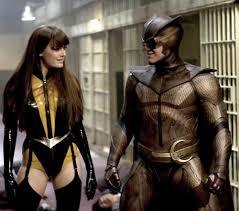
In fact the film takes it one step further by having Nite Owl punch Adrian repeatedly in the face and accuse him of deforming humanity, which completely contradicts the point of Dan Dreiberg as a character. He’s no longer the pathetic centrist who requires a superhero identity to feel any sort of power or validation. He’s now the everyman representing the views of the audience, which just feels utterly wrong.
This links in with arguably the film’s biggest problem of all. The way it portrays superheroes in general. The use of slow motion, cinematography and fight choreography frames the superheroes and vigilantes of Watchmen as being powerful, impressive individuals, when really the exact opposite should be conveyed. The costumes give the characters a feeling of power, but that power is an illusion. Nite Owl is really an impotent failure. Rorschach is an angry bigot lashing out at the world. The Comedian is a depraved old man who has let his morals fall by the way side so he can indulge in his own perverse fantasies. They’re not people to be idealised. They’re to be at pitied at best and reviled at worst. So seeing them jump through windows and beating up several thugs single handed through various forms of martial arts ultimately confuses the message, as does the use of gratuitous gore and violence. Are we supposed to be shocked by these individuals or in awe?
Costumes too have a similar problem. Nite Owl and Ozymandias’ costumes have been updated so they look more imposing, which kind of defeats the purpose of them. The point is they look silly to us, the outside observers, but they make the characters feel powerful. That juxtaposition is lost in the film. And then there’s the Silk Spectre. In the graphic novel, both Sally and Laurie represent the changing attitudes of women in comics and in society. Both Silk Spectres are sexually objectified, but whereas Sally accepts it as part of the reality of being a woman, Laurie resists it, seeing it as demeaning. The only reason she wore her revealing costume in A Brother To Dragons was because she knew that Dan found it sexually attractive and she wanted to indulge his power fantasy. None of this is touched upon in the film, other than one passing mention of the Silk Spectre porn magazine near the beginning of the film. There’s not even any mention of how impractical her costume is, like the graphic novel does. Yes the film changes her look drastically, but it’s still just as impractical and could have been used to make a point on how women are perceived in comic book films, but it never seems to hinder her in anyway. It’s never even brought up, which is ridiculous. Zack Snyder’s reinterpretation of Silk Spectre is clearly meant to inject some form of girl power into the proceedings, as she’s presented as being just as impressive and kick-ass as the others, when the whole point of her character was to expose the misogyny of the comics industry at the time and how they cater to the male gaze. Now don’t get me wrong, I’m not saying the graphic novel did it perfectly, but it did it a hell of a lot better than this.
Die hard fans have described the film over the years as shallow and ‘style over substance.’ I don’t think that’s entirely fair. It’s clear that Zack Snyder has a huge respect for the graphic novel and wanted to do it justice. Overall the film has a lot of good ideas and is generally well made. However, as much as Snyder seems to love Watchmen, it does seem like he only has a surface level understanding of it, hence why the attention and effort seems to be going into the visuals and the faithfulness to Alan Moore’s attention to detail rather than the Watchmen’s story and themes. While the film at times makes some good points about power, corruption and morality, it doesn’t go nearly as far as the source material does and seems to shy away from really getting into the meat of any particular topic. Part of that I suspect is to do with marketability, not wanting to alienate casual viewers, but I think a lot of it is to do with it simply being in the wrong medium. I personally don’t think you can really do a story as complex and intricate as Watchmen’s justice in a Hollywood film. In my opinion, this really should have been a TV mini-series or something.
So on the whole, while I appreciate Snyder’s attempt at bringing the story of Watchmen to life and can see that he has the best intentions in mind, I don’t think this film holds a candle to the original source material.
21 notes
·
View notes
Text
Regina King, Damon Lindelof capture comics’ spirit on HBO
CLOSE

Characters of HBO’s ‘Watchmen’ including Regina King, Jean Smart and Jeremy Irons talk about their favorite bits of alternative history in the show.
USA TODAY
The 2019 landscape of HBO’s “Watchmen” has its reality-stretching quirks: a godlike guy hanging out on Mars, the presence of dirigibles but not cellphones, and President Robert Redford. Oh, and don’t forget the rainstorms of interdimensional baby alien squid.
Look closer, though, and the highly anticipated continuation of the seminal 1980s comic book series shows a divided America not unlike our own as it tackles class struggles, systemic racism and white supremacy. And it’s a new “Watchmen” (premiering Sunday, 9 EDT/PDT) that fully embraces the politically charged and completely bonkers spirit of what came before.
“The world of ‘Watchmen,’ that comic did not shy away at all,” says star Yahya Abdul-Mateen II. The modern followup acts as “a reminder of our dark history, but also our dark present we’re living in and dealing with right now.”
What we thought: Review: HBO’s ‘Watchmen’ wants to end racism, but it’s better at telling superhero stories
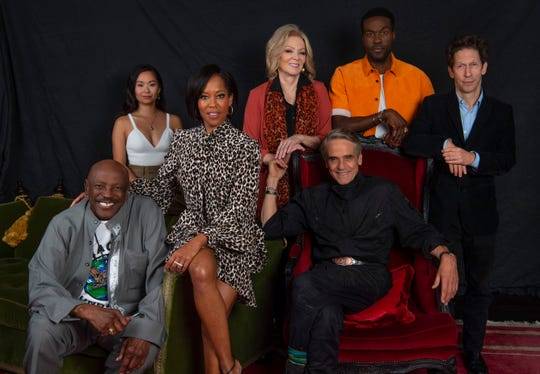
HBO’s highly anticipated “Watchmen” series stars (from left) Louis Gossett Jr., Hong Chao, Regina King, Jean Smart, Jeremy Irons, Yahya Abdul-Mateen II and Tim Blake Nelson. (Photo: ROBERT DEUTSCH/USA TODAY)
Both the comic and TV version of “Watchmen” (there was also a 2009 film) are alternate histories of the United States, exploring the ripple effects if superheroes were real. In their history, we won the Vietnam War with the help of the supremely powerful Dr. Manhattan and the Asian nation became the 51st state. And Richard Nixon wasn’t taken down by Watergate, but instead nixed term limits and served into the 1980s.
The HBO series is set 34 years after the events of the comic, which took place in an alternate 1985 and saw World War III staved off by a space squid that landed in New York City and killed 3 million people with a psychic blast. This “Watchmen” begins with the 1921 Tulsa Race Massacre and follows that city’s cops, who wear yellow masks to keep their identities secret. They’re fighting the terrorist group Seventh Kavalry, a modern version of the Ku Klux Klan clad in the headwear of infamous Watchmen vigilante Rorschach.
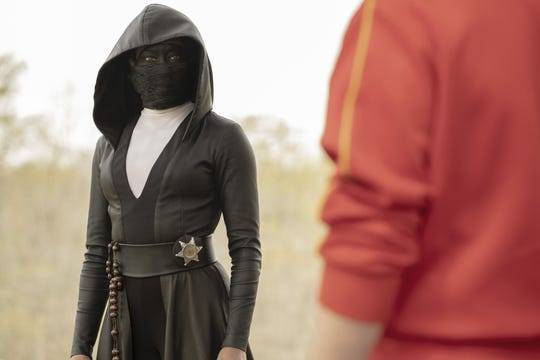
Masked cop Angela Abar (Regina King) leads the effort against the white supremacist group Seventh Kavalry in “Watchmen.” (Photo: MARK HILL/HBO)
Initially, executive producer Damon Lindelof (“The Leftovers,” “Lost”) was concerned about “being a cover band, trying to rip off the original ‘Watchmen.’ ” So he aimed to be as original as the ‘80s storyline: Before weaving in elements of the past, the nine-episode first season focuses on Angela Abar (Regina King), a detective who goes by the superhero moniker Sister Night, and other new characters including her husband, Cal Abar (Abdul-Mateen), human lie detector Looking Glass (Tulsa, Oklahoma, native Tim Blake Nelson) and wheelchair-bound mystery man Will Reeves (Louis Gossett Jr.).
Old-school personalities are there, too, and not just Dr. Manhattan on his Martian sojourn. FBI agent Laurie Blake (Jean Smart), an original “Watchmen” superhero known as Silk Spectre who now takes down costumed vigilantes, is called to Tulsa and becomes involved in the problems and conspiracies. Enigmatic trillionaire Lady Trieu is also in town, building the equally puzzling Millennium Clock. Then there’s the comic’s hero-turned-antagonist Adrian Veidt (Jeremy Irons), who’s involved in a strange bit of business at bucolic castle estate.
Listen to this week’s episode of USA TODAY’s podcast, The Mothership, to hear our TV Critic’s six episode review of HBO’s “Watchmen” in the player below.
Lindelof likens a viewer unfamiliar with the “Watchmen” saga to an early follower of Christianity who first hears of Jesus Christ, but finds the New Testament didn’t erase the Old: “Everything that you know is true – Adam and Eve, Noah and the Ark, Daniel in the lion’s den, the parting of the Red Sea, all of that stuff happened – but we want to tell you this new story as well.”
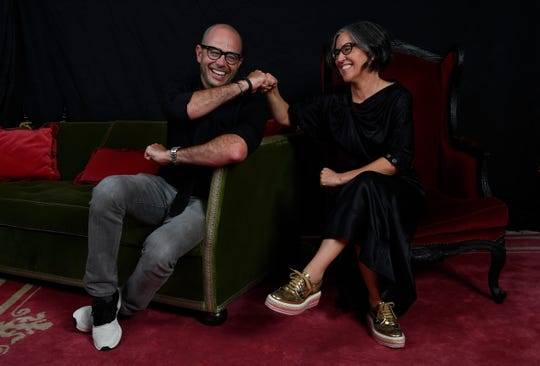
Executive producers Damon Lindelof and Nicole Kassell are creative forces behind HBO’s “Watchmen,” a continuation of the seminal 1980s comic book. (Photo: ROBERT DEUTSCH/USA TODAY)
The seminal “Watchmen” comic is considered sacrosanct by many. “It really touched me that it’s truly adult,” says executive producer Nicole Kassell, who directs the first two episodes. “There are some very poetic, poignant statements.”
Smart also was unfamiliar with the comic, although her son’s friend “just about passed out” learning she’d be playing an iconic character. Chau hadn’t heard of it either, leading Lindelof to spend two and a half hours explaining the story. “I was like, ‘Wait, what’s going on?!’ It was a lot to digest.”
Irons is another self-described “Watchmen virgin” who stars as the genius antagonist Adrian, whose bizarre journey in the show borrows from the tale-within-a-tale aspect of the comic. “We’re used to storytelling like this at the moment,” he says. “It demands quite a lot of the audience, and I think it’s interesting.”

Jeremy Irons stars as original “Watchmen” character Adrian Veidt in the new HBO series. (Photo: COLIN HUTTON/HBO)
The “Watchmen” comics deconstructed the popular superheroes of the ‘80s, but Lindelof instead focuses on another central theme, how masks cover one’s face yet also reveal something about identity. “We all hide little parts of ourselves, even if it’s just hiding behind sarcasm,” Smart says.
King’s main protagonist wears multiple masks – physical and metaphorical – and “she’s a representation of just every human being,” the actress says. “We switch our masks all the time.”
Gossett connected to that element, and says “it goes deeper than Damon realized. He touched on something very sensitive. From the end of slavery until now, everybody has had to wear a mask of some sort. Our mutual survival as a people has to do with us dropping those masks, once and for all.”

Laurie Blake (Jean Smart) was a superhero in the 1980s and now is an FBI agent hunting masked vigilantes in “Watchmen.” (Photo: MARK HILL/HBO)
Digging into issues of the day is also a “Watchmen” hallmark. The original comic wrestled with Cold War paranoia and nuclear fears, so it made sense to Lindelof that race be central to the new series. And “because I’m a white guy,” making sure he treated those issues with respect worried and challenged him.
“I can listen to the ‘1619’ podcast or talk about all the Ta-Nehisi Coates books I’ve read until I’m blue in the face,” Lindelof says. But “when I walk into a department store, nobody is following me around. I’m not getting pulled over. But at the same time, I don’t think that you can tell any story, fictional or otherwise, that sort of models the realities of living in America today that is not dealing with race. It just comes up in every way, shape and form.”

Eccentric masked man Looking Glass (Tim Blake Nelson, center) is a part of a Tulsa police force who hide their identities in “Watchmen.” (Photo: MARK HILL/HBO)
The show “is a version of our world, but it also pokes at (the issue of), well, we can end up here,” King says. “You can’t help but kind of go, ‘Huh. Did Damon have a crystal ball in some ways?” Angela represents “the history of black people in America: It’s your history, taken away from you and not knowing where you’re from.”
“Watchmen” is an alt-history tale, yet its extremes “reflect back on us exactly what we’re experiencing in America right now in terms of friction points,” says Nelson. It’s the kind of show that examines those points “and demands that, yes, it is worth picking at some of these scars.”
Autoplay
Show Thumbnails
Show Captions
Last SlideNext Slide
Read or Share this story: https://www.usatoday.com/story/entertainment/tv/2019/10/18/damon-lindelof-captures-original-watchmen-spirit-new-hbo-series/3994130002/
Sahred From Source link TV and Movies
from WordPress http://bit.ly/2qr2mPi
via IFTTT
0 notes
Text
Oct. 4, 2017: Columns
Come to the fair...
By KEN WELBORN
Record Publisher
Once again we are blessed here in Wilkes to have a busy week of entertainment for the entire family.
The Wilkes Agricultural Fair, which is sponsored by the Rotary Club of North Wilkesboro, is going on all this week at the Rotary Fairgrounds off West D Street in North Wilkesboro. There are more than 25 rides on the midway along with plenty of good food and fun games. It truly is a family event with an amazing array of 4-H exhibits, a wide variety of entertainment, and even a hay bale decorating contest. Really, you have no idea how cool a big round hay bale can look! Also, children can enter the N. C. Department of Agriculture Scavenger Hunt to win a bicycle or a smart tablet computer.
The fair opens each weekday at 5 pm and Saturday at 1 pm. An added attraction n Saturday is the last Lawn Mower Race of the season. Gates open at 2pm, practice begins at 4:30 pm, and racing begins at 6 pm. An admission to the fairgrounds includes admission to the Lawn Mower Race as well.
If you are reading this piece on Wednesday morning, it is about the time that the Rotarians are enjoying their highlight of the fair. Because it is on Wednesday each year that the gates are opened at 10:00 am for what has become the most anticipated event of the year—for both Rotarians and their very special guests--the Exceptional Children and Adults from throughout the county. The parking area of the fairgrounds is literally covered with buses and vans, and the squeals and laughter can be heard across the midway.
The carnival's operator, Bill and Donna Inners of Inners Shows, open up their rides to these very special folks, and the other vendors and acts do the same. These include the E-Z Ride Petting Zoo, NoJoe's Clown Circus, and the ever popular music of Buffalo Barfield and his wife, the lovely Bumadean. To top it all off, there will probably be some of the N. E. W. Extreme Wrestling stars roaming the fairgrounds in full costume, posing for pictures and doing their part to make this very special event even more fun.
While all the Rotary guests and their caregivers are being entertained on the midway, a group of Rotarians, aided by our friends at the Brushy Mountain Smokehouse and Creamery in North Wilkesboro, will be preparing to serve lunch to nearly 600 people. This is no small undertaking, but is cheerfully accomplished by a small army of members, spouses, and other volunteers who always show up to work for this special project. Believe it or not, 600 people will be served hamburgers and hotdogs, with all the trimmings, along with a cookie and a cold drink in 45 minutes or less.
Just to watch the interactions between these children and adults and their caregivers is a blessing in an of itself. It is not uncommon to see tears in the eyes of the people serving the food as they watch the line move along in front of them as everyone prepares to enjoy their lunch and enjoy even more entertainment.
The dedicated people who take care of this myriad variety of special needs children and adults tell us that they look forward to their day at the fair almost like another Christmas.
I know the Rotarians do.
One year it rained every day except for the five hours of the Wednesday Exceptional Children time. Over and over I heard it said,, if that had to be the only clear weather for the week, that was fine with them. One of our past presidents, Tim York, put it best when he said, “Wednesday's special day for the children at the fair is the only Rotary project we never have to send around a sign up sheet for--they just come.”
They get to ride, they get to laugh, they get to see their friends, and they get to enjoy a great picnic lunch; all the while surrounded by people who love and care about them. Clearly, on this day these special children and adults are the rule, not the exception.
And, Rotarians are all the better for it.
Trust
By LAURA WELBORN
Sometimes it seems that life is just about surviving, but after listening to Rev. Anne Dieterle this Sunday I was reminded of the words my mother used to say: “We can’t do everything but we can do something.”
Anne talked about going beyond survival and adding beauty and joy through play and creativity. If God is in our lives and we really believe that then we must live like we trust we will not just survive but thrive. I find myself living like a functional atheist- I want to trust and to believe yet I work like I don’t believe things will be ok. What we do every day defines us so we need to be intentional in our actions and act like we mean it…
1. It is about showing up every day with the intention to be your best self, and to do the best you know how, without expecting life to go a certain way. Focus on what matters—what moves you forward today—and let go of what does not.
2. Most of us don’t want to be uncomfortable, so we run from the possibility of discomfort constantly. The obvious problem with this is that, by running from discomfort, we only do activities and opportunities within our comfort zones. And since our comfort zones are relativity small, we miss out on most of life’s greatest experiences. We keep doing what we’ve always done, and thus we keep getting the results we’ve always gotten. Instead go to environments that expand your mind. Spend time with people who inspire you to stretch yourself. Take time to do the fun things be creative and play more.
3. Remind yourself to take a deep breath when things don’t go your way. Your results in the long run—good or bad—are always the byproduct of many small decisions, outcomes, and events over time. The truth is we all fail sometimes. The greater truth is that no single failure ever defines us. Learn from your mistakes. Grow wiser. Press on. Character and wisdom are sculpted gradually. They come with loss, lessons, and triumphs. They come after doubts, second guesses, and unknowns.
4. Calmness is a human superpower. The ability to not overreact or take things personally keeps your mind clear, your heart at peace, and yourself moving forward. Take constructive criticism seriously, but not personally. Listen to others, and then operate with your own intuition and wisdom as your guide.
5. Do your best to focus inward whenever you need a moment to refocus. Time spent focusing inward doesn’t just help you—your mind is powerful and your thoughts create ripples in other people’s lives. When you bring clarity into your life, you bring the best of yourself into everything you do—you tend to treat yourself and others better, communicate more constructively, do things for the right reasons, and ultimately improve the world you’re living in. This is why praying, or just meditating on positive mantras, on a daily basis can actually make a real-world difference in your life.
Start taking the next small, insignificant step (one at a time, every day) and you might be surprised where you end up. (inserts from Marc and Angel Hack life blog)
Laura Welborn, Mediator, LCAS. Contact [email protected]
State’s Secrets and the Swamp that Needs Draining
By EARL COX
Special to The Record
President Donald Trump blocked a recent State Department effort to force Israel to return $75 million in military aid, the department’s most recent attempt to erode the U.S.-Israel military alliance. State’s demand was shocking, but it shouldn’t be surprising.
Rex Tillerson's State Department has been embroiled in a power struggle with the White House, thwarting its efforts to remove Obama holdovers - and Trump nominees from filling open staff positions.
But long before Obama appointees clogged Trump's efforts to drain the swamp, previous administrations dealt with State Department undertow. Generally conflicts between DOS and the White House, Congress and the courts, are turf wars over who controls foreign policy. This dynamic has plagued several administrations - and impacted U.S. relations with Israel.
Anti-Semitism has lurked in State’s corridors for decades, and under the guise of diplomacy, has used subversive or covert tactics to manipulate foreign policy. Despite pressure from his State Department, Herbert Hoover defended the concept of a Jewish state; and under Franklin D. Roosevelt, DOS-mandated immigration policy “severely limited” German Jewish immigration during the Holocaust, and visas for Jewish refugees in Vichy France, according to Rafael Medoff, founding director of the David S. Wyman Institute for Holocaust Studies. Harry S. Truman stood against his State Department by supporting Israel’s establishment in 1948—while behind his back an undersecretary threatened to “foment anti-Semitism that could destroy the fledgling Jewish government’s support base in the U.S.” unless Zionist leaders caved to his demands, Medoff said.
The State Department is still working to undermine and intimidate Israel. Recently, it hosted the U.S. Council of Muslim Organizations, an umbrella of American Muslim groups such as the anti-Israel, pro-BDS, American Muslims for Palestine. The meeting’s announcement on AMP’s website expressed “concern” about “Israel's denial of religious rights for Muslims and Christians.” Israel is the sole country in the Middle East that protects the rights of all religions—Muslims, Christians, Jews and Druze. USCMO secretary general Oussama Jammal remarked the group was encouraged by “the constructive dialogue at the State Department.”
The Center for Security Policy warned in 2015 that USCMO leads the Islamic Movement in the United States “in pursuit of Civilization Jihad.” Jammal, who has a track record of seeking out strategic relationships with the U.S. government on behalf of the Muslim Brotherhood, is connected to Saul Alinsky’s Industrial Areas Foundation, a Marxist-Leninist organization “dedicated to revolution in America,” CSP said. Another nip at Israel’s heels is the just-released State Department 2016 Country Reports on Terrorism. The report blames Israel for Palestinian terrorism against Israelis, citing the Palestinians’ “lack of hope” in the peace process. Tillerson’s report whitewashes Palestinian Authority leaders’ incitement of violence and financial support for terrorists. It also defines PA calls for terrorism and violence against Israelis as "rare,” and says the PA leadership “does not generally tolerate it.”
In response, Rep. Peter Roskam, co-chair of the House Republican Israel Caucus, sent a letter to Tillerson noting “harmful mischaracterizations” in the report that impair the peace process. “To effectively combat terrorism,” he wrote, the United States must “accurately characterize its root cause—the PA leadership … and clarify … Palestinian support for terrorism as the leading impediment to Israeli-Palestinian peace."
In a strike against the heart of its own republic, a senior State Department contracting officer tried to silence two security contractors disturbed by deteriorating security at the U.S. Embassy in Libya prior to the tragic 2012 attack, a recent Fox News report revealed. The officer also asked the contractors to publically agree with State that “guards should not be armed at U.S. embassies” and “they weren't required in Benghazi.” Those responsible for the lapses and cover-up in Libya are still in place, the contractors said.
The State Department has more than 300 embassies, consulates and diplomatic missions around the world. In a healthy democracy that’s not under siege, this would be an indicator of positive national influence thrin a government divided against itself, it’s dangerous—not only for the U.S.-Israel alliance, but also for the future of American foreign policy
This mammoth organization endangers the democratic process by collaborating with a Deep State—reminiscent of dictatorships with democratic facades. By breaching public trust with secrecy, veiled threats and disregard of human life—including its own—it demonstrates moral compromise and disregard for the democratic process. Unless the Trump Administration can rein it this rogue department, it endangers America and puts our allies at risk. Trump must unclog and drain the swamp before another debacle—or tragedy—occurs.
0 notes
Text
Regina King, Damon Lindelof capture comics’ spirit on HBO
CLOSE

Characters of HBO’s ‘Watchmen’ including Regina King, Jean Smart and Jeremy Irons talk about their favorite bits of alternative history in the show.
USA TODAY
The 2019 landscape of HBO’s “Watchmen” has its reality-stretching quirks: a godlike guy hanging out on Mars, the presence of dirigibles but not cellphones, and President Robert Redford. Oh, and don’t forget the rainstorms of interdimensional baby alien squid.
Look closer, though, and the highly anticipated continuation of the seminal 1980s comic book series shows a divided America not unlike our own as it tackles class struggles, systemic racism and white supremacy. And it’s a new “Watchmen” (premiering Sunday, 9 EDT/PDT) that fully embraces the politically charged and completely bonkers spirit of what came before.
“The world of ‘Watchmen,’ that comic did not shy away at all,” says star Yahya Abdul-Mateen II. The modern followup acts as “a reminder of our dark history, but also our dark present we’re living in and dealing with right now.”
What we thought: Review: HBO’s ‘Watchmen’ wants to end racism, but it’s better at telling superhero stories

HBO’s highly anticipated “Watchmen” series stars (from left) Louis Gossett Jr., Hong Chao, Regina King, Jean Smart, Jeremy Irons, Yahya Abdul-Mateen II and Tim Blake Nelson. (Photo: ROBERT DEUTSCH/USA TODAY)
Both the comic and TV version of “Watchmen” (there was also a 2009 film) are alternate histories of the United States, exploring the ripple effects if superheroes were real. In their history, we won the Vietnam War with the help of the supremely powerful Dr. Manhattan and the Asian nation became the 51st state. And Richard Nixon wasn’t taken down by Watergate, but instead nixed term limits and served into the 1980s.
The HBO series is set 34 years after the events of the comic, which took place in an alternate 1985 and saw World War III staved off by a space squid that landed in New York City and killed 3 million people with a psychic blast. This “Watchmen” begins with the 1921 Tulsa Race Massacre and follows that city’s cops, who wear yellow masks to keep their identities secret. They’re fighting the terrorist group Seventh Kavalry, a modern version of the Ku Klux Klan clad in the headwear of infamous Watchmen vigilante Rorschach.
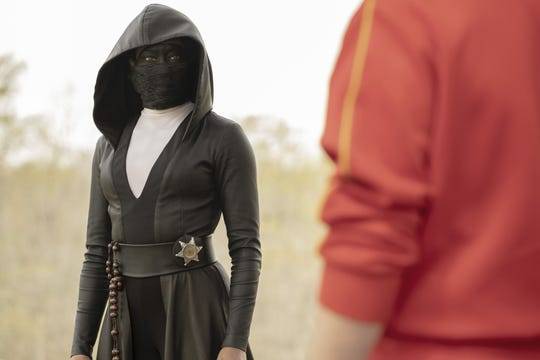
Masked cop Angela Abar (Regina King) leads the effort against the white supremacist group Seventh Kavalry in “Watchmen.” (Photo: MARK HILL/HBO)
Initially, executive producer Damon Lindelof (“The Leftovers,” “Lost”) was concerned about “being a cover band, trying to rip off the original ‘Watchmen.’ ” So he aimed to be as original as the ‘80s storyline: Before weaving in elements of the past, the nine-episode first season focuses on Angela Abar (Regina King), a detective who goes by the superhero moniker Sister Night, and other new characters including her husband, Cal Abar (Abdul-Mateen), human lie detector Looking Glass (Tulsa, Oklahoma, native Tim Blake Nelson) and wheelchair-bound mystery man Will Reeves (Louis Gossett Jr.).
Old-school personalities are there, too, and not just Dr. Manhattan on his Martian sojourn. FBI agent Laurie Blake (Jean Smart), an original “Watchmen” superhero known as Silk Spectre who now takes down costumed vigilantes, is called to Tulsa and becomes involved in the problems and conspiracies. Enigmatic trillionaire Lady Trieu is also in town, building the equally puzzling Millennium Clock. Then there’s the comic’s hero-turned-antagonist Adrian Veidt (Jeremy Irons), who’s involved in a strange bit of business at bucolic castle estate.
Listen to this week’s episode of USA TODAY’s podcast, The Mothership, to hear our TV Critic’s six episode review of HBO’s “Watchmen” in the player below.
Lindelof likens a viewer unfamiliar with the “Watchmen” saga to an early follower of Christianity who first hears of Jesus Christ, but finds the New Testament didn’t erase the Old: “Everything that you know is true – Adam and Eve, Noah and the Ark, Daniel in the lion’s den, the parting of the Red Sea, all of that stuff happened – but we want to tell you this new story as well.”
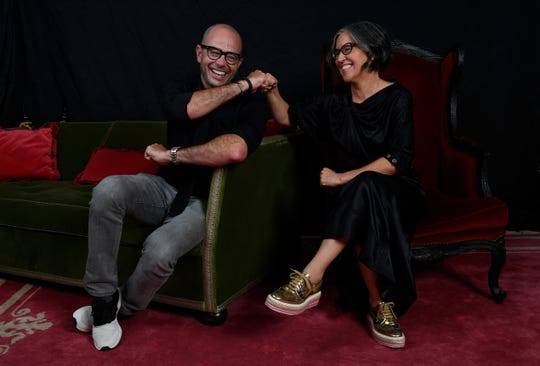
Executive producers Damon Lindelof and Nicole Kassell are creative forces behind HBO’s “Watchmen,” a continuation of the seminal 1980s comic book. (Photo: ROBERT DEUTSCH/USA TODAY)
The seminal “Watchmen” comic is considered sacrosanct by many. “It really touched me that it’s truly adult,” says executive producer Nicole Kassell, who directs the first two episodes. “There are some very poetic, poignant statements.”
Smart also was unfamiliar with the comic, although her son’s friend “just about passed out” learning she’d be playing an iconic character. Chau hadn’t heard of it either, leading Lindelof to spend two and a half hours explaining the story. “I was like, ‘Wait, what’s going on?!’ It was a lot to digest.”
Irons is another self-described “Watchmen virgin” who stars as the genius antagonist Adrian, whose bizarre journey in the show borrows from the tale-within-a-tale aspect of the comic. “We’re used to storytelling like this at the moment,” he says. “It demands quite a lot of the audience, and I think it’s interesting.”
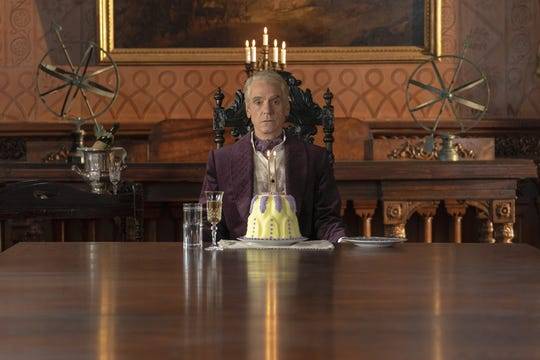
Jeremy Irons stars as original “Watchmen” character Adrian Veidt in the new HBO series. (Photo: COLIN HUTTON/HBO)
The “Watchmen” comics deconstructed the popular superheroes of the ‘80s, but Lindelof instead focuses on another central theme, how masks cover one’s face yet also reveal something about identity. “We all hide little parts of ourselves, even if it’s just hiding behind sarcasm,” Smart says.
King’s main protagonist wears multiple masks – physical and metaphorical – and “she’s a representation of just every human being,” the actress says. “We switch our masks all the time.”
Gossett connected to that element, and says “it goes deeper than Damon realized. He touched on something very sensitive. From the end of slavery until now, everybody has had to wear a mask of some sort. Our mutual survival as a people has to do with us dropping those masks, once and for all.”

Laurie Blake (Jean Smart) was a superhero in the 1980s and now is an FBI agent hunting masked vigilantes in “Watchmen.” (Photo: MARK HILL/HBO)
Digging into issues of the day is also a “Watchmen” hallmark. The original comic wrestled with Cold War paranoia and nuclear fears, so it made sense to Lindelof that race be central to the new series. And “because I’m a white guy,” making sure he treated those issues with respect worried and challenged him.
“I can listen to the ‘1619’ podcast or talk about all the Ta-Nehisi Coates books I’ve read until I’m blue in the face,” Lindelof says. But “when I walk into a department store, nobody is following me around. I’m not getting pulled over. But at the same time, I don’t think that you can tell any story, fictional or otherwise, that sort of models the realities of living in America today that is not dealing with race. It just comes up in every way, shape and form.”

Eccentric masked man Looking Glass (Tim Blake Nelson, center) is a part of a Tulsa police force who hide their identities in “Watchmen.” (Photo: MARK HILL/HBO)
The show “is a version of our world, but it also pokes at (the issue of), well, we can end up here,” King says. “You can’t help but kind of go, ‘Huh. Did Damon have a crystal ball in some ways?” Angela represents “the history of black people in America: It’s your history, taken away from you and not knowing where you’re from.”
“Watchmen” is an alt-history tale, yet its extremes “reflect back on us exactly what we’re experiencing in America right now in terms of friction points,” says Nelson. It’s the kind of show that examines those points “and demands that, yes, it is worth picking at some of these scars.”
Autoplay
Show Thumbnails
Show Captions
Last SlideNext Slide
Read or Share this story: https://www.usatoday.com/story/entertainment/tv/2019/10/18/damon-lindelof-captures-original-watchmen-spirit-new-hbo-series/3994130002/
Sahred From Source link TV and Movies
from WordPress http://bit.ly/2P3o6Ln
via IFTTT
0 notes